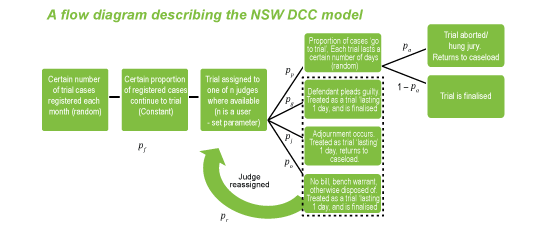Summary
Aim
To determine the effect of various possible reforms on the pending case backlog in the Sydney registry of the NSW District Criminal Court using a simulation model. Specifically to determine what (if any) interventions can reduce the case backlog to 430 cases or fewer by December 31 2019.
Method
A simulation model was developed using the R statistical software package, and was used to determine the likely effect of various initiatives in reducing trial court delay.
Results
If no preventative measures are taken, the backlog will rise from the July 2016 level of 702 cases to approximately 796 cases by December 2019. The only intervention which will reduce the case backlog to 430 cases or fewer by December 2019 is the addition of 5 or more judges (a 33% increase), which would reduce the backlog to (on average) 375 cases by December 2019. A 75% reduction in late guilty pleas would result in the backlog falling to 725 cases, any reduction in trial-day adjournments would have virtually no effect, and the elimination of the mid-year court vacation would result in the backlog falling to 648 cases. A combination of 2 additional judges (an 11% increase), a 50% reduction in late guilty pleas, a 33% reduction in adjournments and the elimination of the mid-year vacation periods would also reduce the backlog to (on average) 564 cases by December 2019.
Conclusion
The only intervention which could reduce the backlog to 430 cases or less by December 2019 is the addition of 5 or more judges to the Sydney registry of the NSW District Criminal Court. A combination of 2 additional judges (an 11% increase), a 50% reduction in late guilty pleas, a 33% reduction in adjournments and the elimination of the mid-year vacation would achieve a smaller but still significant reduction.
